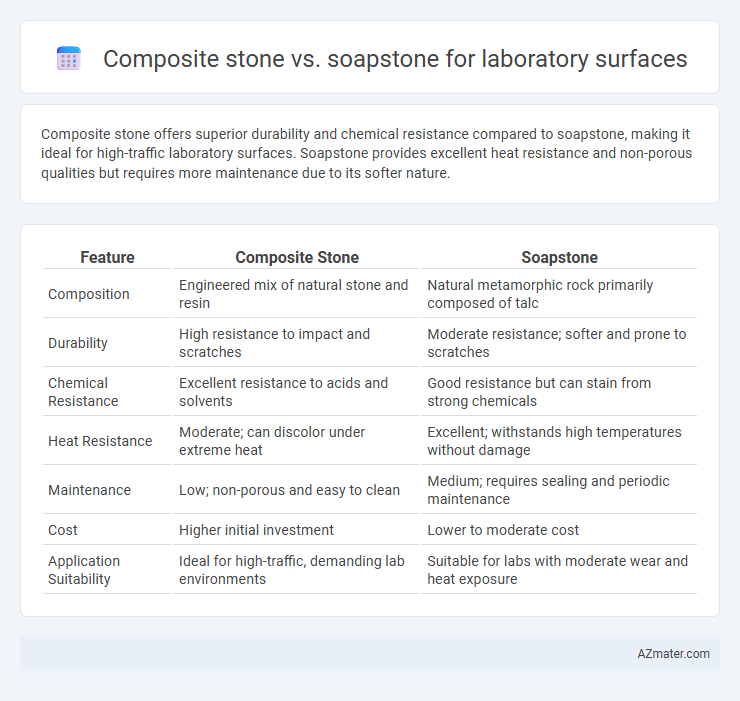Composite stone offers superior durability and chemical resistance compared to soapstone, making it ideal for high-traffic laboratory surfaces. Soapstone provides excellent heat resistance and non-porous qualities but requires more maintenance due to its softer nature.
Table of Comparison
| Feature | Composite Stone | Soapstone |
|---|---|---|
| Composition | Engineered mix of natural stone and resin | Natural metamorphic rock primarily composed of talc |
| Durability | High resistance to impact and scratches | Moderate resistance; softer and prone to scratches |
| Chemical Resistance | Excellent resistance to acids and solvents | Good resistance but can stain from strong chemicals |
| Heat Resistance | Moderate; can discolor under extreme heat | Excellent; withstands high temperatures without damage |
| Maintenance | Low; non-porous and easy to clean | Medium; requires sealing and periodic maintenance |
| Cost | Higher initial investment | Lower to moderate cost |
| Application Suitability | Ideal for high-traffic, demanding lab environments | Suitable for labs with moderate wear and heat exposure |
Introduction to Laboratory Surface Materials
Composite stone and soapstone are prominent materials for laboratory surfaces due to their chemical resistance and durability. Composite stones, made from engineered aggregates and resin, offer enhanced strength and non-porous properties ideal for withstanding harsh chemical exposure. Soapstone, a natural metamorphic rock, provides excellent heat resistance and low porosity, making it suitable for laboratory environments requiring corrosion resistance and easy maintenance.
Overview of Composite Stone Surfaces
Composite stone surfaces for laboratory use consist of a blend of natural quartz or other minerals bonded with resin, offering high durability and resistance to chemicals and stains. These surfaces provide excellent non-porous properties, minimizing contamination risks and facilitating easier cleaning compared to natural stones. Their enhanced strength and versatility make composite stones a preferred choice for demanding laboratory environments requiring consistent performance and low maintenance.
Overview of Soapstone Surfaces
Soapstone surfaces in laboratories offer excellent chemical resistance and durability, making them ideal for environments exposed to acids and solvents. Their dense, non-porous nature prevents staining and microbial growth, ensuring a hygienic workspace. Compared to composite stone, soapstone requires less maintenance and provides natural heat resistance, enhancing safety during high-temperature procedures.
Durability Comparison: Composite Stone vs Soapstone
Composite stone surfaces feature enhanced durability due to their engineered resin and quartz blend, offering superior resistance to scratches, stains, and chemical exposure commonly encountered in laboratory environments. Soapstone, composed primarily of talc and magnesium silicate, provides moderate durability with excellent resistance to acids and heat but is more prone to scratching and wear over time. In high-use laboratories, composite stone generally outperforms soapstone by maintaining structural integrity and surface quality under frequent chemical and mechanical stress.
Chemical Resistance and Laboratory Suitability
Composite stone surfaces offer excellent chemical resistance against acids, bases, and solvents commonly found in laboratories, making them highly suitable for harsh chemical environments. Soapstone exhibits outstanding resistance to chemical corrosion and thermal shock, ensuring durability in lab settings that involve frequent exposure to corrosive substances and heat. Both materials provide non-porous structures that minimize contamination risks, but soapstone's natural composition offers superior resistance to stronger acids compared to some composite stones.
Maintenance and Cleaning Requirements
Composite stone laboratory surfaces offer high resistance to stains and scratches, requiring only routine wiping with mild soap and water to maintain cleanliness and durability. Soapstone surfaces, though naturally non-porous and chemically resistant, demand regular oiling or sealing to prevent surface dullness and maintain their smooth texture. Both materials support easy maintenance, but composite stone generally requires less frequent upkeep compared to soapstone's periodic treatment needs.
Cost Analysis of Composite Stone and Soapstone
Composite stone generally offers a lower initial cost compared to soapstone, making it a budget-friendly option for laboratory surfaces. Soapstone, while more expensive upfront, boasts superior chemical resistance and durability, potentially reducing long-term maintenance expenses. Evaluating total cost of ownership, including installation, maintenance, and lifespan, is essential when comparing composite stone and soapstone for laboratory environments.
Aesthetic and Design Considerations
Composite stone offers a sleek, uniform appearance with customizable colors and patterns, making it ideal for laboratories focused on modern aesthetics and seamless countertop design. Soapstone provides a natural, matte finish with subtle veining, appealing to environments that value rustic charm and organic textures. Both materials complement various laboratory designs but differ fundamentally in their visual impact and textural qualities.
Environmental Impact and Sustainability
Composite stone surfaces for laboratories often incorporate recycled materials and offer durability that reduces the need for frequent replacement, minimizing waste. Soapstone is a natural material known for its longevity and resistance to chemicals, with minimal processing that lowers its carbon footprint compared to engineered alternatives. Both materials provide sustainable options, but soapstone's extraction and minimal manufacturing processes generally result in a smaller environmental impact.
Choosing the Best Laboratory Surface Material
Composite stone offers superior chemical resistance and durability, making it ideal for laboratory surfaces exposed to harsh reagents and frequent cleaning. Soapstone provides excellent heat resistance and natural resistance to acids but is softer and more prone to scratching and staining compared to composite stone. Choosing the best laboratory surface material depends on balancing chemical stability, mechanical durability, and maintenance requirements tailored to specific lab activities.

Infographic: Composite stone vs Soapstone for Laboratory Surface
 azmater.com
azmater.com